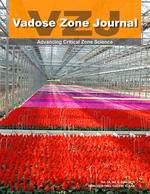Nyquist et al., 2018
Testing the Fill-and-Spill Model of Subsurface Lateral Flow Using Ground-Penetrating Radar and Dye Tracing
Nyquist, J. E., L. Toran, L. Pitman, L. Guo, and H. Lin (2018)
Vadose Zone Journal, 17:170142
-
Christina, Shale Hills, COLLABORATOR
-
Christina, Shale Hills, INVESTIGATOR, COLLABORATOR
-
Shale Hills, INVESTIGATOR
-
IML, Shale Hills, INVESTIGATOR
Abstract
Preferential flow (PF), which bypasses large portions of the soil or subsurface matrix, is critical in the transport of water and dissolved constituents in the unsaturated zone. To test the “fill-and-spill” model of hillslope hydrology that describes the generation and pattern of downslope lateral PF after storms, we used dye tracer and time-lapse, ground-penetrating radar (GPR) on a forested hillslope in the Susquehanna–Shale Hills Critical Zone Observatory. We injected 50 L of water mixed with Brilliant Blue dye (4 g L−1) into a shallow trench cut perpendicular to the slope and used GPR to monitor the tracer downslope across a 1.0- by 2.0-m grid. The site was then excavated to the soil–saprock interface and photographed to document the dye pathways. We observed vertical dye fingering near the infiltration trench. Downslope lateral PF at the soil–saprock boundary was limited to ~0.40 m, which is evidence that the soil–saprock interface did not fill-and-spill. The extent, depth, and direction of the downslope PF indicated by GPR generally matched the dye staining patterns in the excavation, but the resolution of the 800-MHz GPR antenna was insufficient to distinguish small fingers of dye. A revised filland-spill model was proposed for this site that incorporates the PF through fractured saprock before water encounters fresh bedrock surface. This study demonstrates that GPR integrated with dye tracer infiltration can provide a useful means of testing hillslope hydrological hypotheses and unraveling the complexity of PF at the hillslope scale in a field setting.
Citation
Nyquist, J. E., L. Toran, L. Pitman, L. Guo, and H. Lin (2018): Testing the Fill-and-Spill Model of Subsurface Lateral Flow Using Ground-Penetrating Radar and Dye Tracing. Vadose Zone Journal, 17:170142. DOI: 10.2136/vzj2017.07.0142
 This Paper/Book acknowledges NSF CZO grant support.
This Paper/Book acknowledges NSF CZO grant support.
Explore Further





